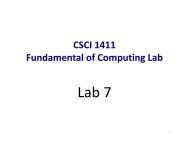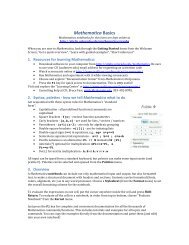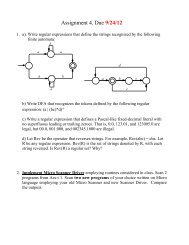[PDF] The Thickness and Chromatic Number of r - Gammeter.com
[PDF] The Thickness and Chromatic Number of r - Gammeter.com
[PDF] The Thickness and Chromatic Number of r - Gammeter.com
You also want an ePaper? Increase the reach of your titles
YUMPU automatically turns print PDFs into web optimized ePapers that Google loves.
2 Terminology <strong>and</strong> Observations<br />
Definition 1. Let G be a graph <strong>and</strong> define the r-inflation <strong>of</strong> G to be the lexicographic<br />
product G[Kr], denoted by G[r]. In the special case that r = 2, we call G[2] the<br />
clone <strong>of</strong> G.<br />
Recall that the lexicographic product G[H] replaces every vertex <strong>of</strong> G with a copy<br />
<strong>of</strong> H <strong>and</strong> places edges between all vertices in copies <strong>of</strong> H that are associated with<br />
adjacent pairs <strong>of</strong> vertices <strong>of</strong> G. That is, the vertex set <strong>of</strong> G[H] is V (G) × V (H) <strong>and</strong><br />
there is an edge between (g1, h1) <strong>and</strong> (g2, h2) if <strong>and</strong> only if g1 = g2 <strong>and</strong> h1 is adjacent<br />
to h2 in H (the vertices are in the same copy <strong>of</strong> H) or g1 is adjacent to g2 in G (the<br />
vertices are in copies <strong>of</strong> H associated with adjacent vertices in G). See, for example,<br />
[Wes01].<br />
From another point <strong>of</strong> view, we obtain G[r] by replacing each vertex <strong>of</strong> G by Kr<br />
<strong>and</strong> replacing each edge <strong>of</strong> G by Kr,r (the join <strong>of</strong> the neighboring Krs). See, for<br />
example, [PST03]. An r-inflation <strong>of</strong> G has the following properties, all <strong>of</strong> which are<br />
straightforward to verify.<br />
Observations:<br />
1. If the number <strong>of</strong> vertices <strong>and</strong> edges <strong>of</strong> G are V <strong>and</strong> E, then the number <strong>of</strong><br />
vertices <strong>and</strong> edges <strong>of</strong> G[r] are rV <strong>and</strong> � � r 2 V + r E respectively.<br />
2<br />
2. If the degree <strong>of</strong> a vertex in G is d then the degree <strong>of</strong> an associated vertex in<br />
G[r] is (d + 1)r − 1.<br />
3. Any edge <strong>of</strong> G (along with its incident vertices) induces a K2r in G[r].<br />
4. If r = st then G[r] = G[st] = G[s][t]. Thus, for example, K1[st] = K1[s][t] =<br />
Ks[t] = Kst. In particular, for any <strong>com</strong>plete graph Ks <strong>and</strong> any positive integer<br />
t, we have Ks[t] = Kst.<br />
5. Independence is invariant under inflation. That is, if the independence number<br />
<strong>of</strong> G is α then the independence number <strong>of</strong> G[r] is α as well.<br />
6. If the clique number <strong>of</strong> G is ω, then the clique number <strong>of</strong> G[r] is rω.<br />
3 <strong>The</strong> <strong>Thickness</strong> <strong>of</strong> Cloned Graphs<br />
In this section we will begin the study <strong>of</strong> cloned graphs. In the next section we will<br />
generalize to r-inflated graphs.<br />
3


![[PDF] The Thickness and Chromatic Number of r - Gammeter.com](https://img.yumpu.com/3978766/3/500x640/pdf-the-thickness-and-chromatic-number-of-r-gammetercom.jpg)





